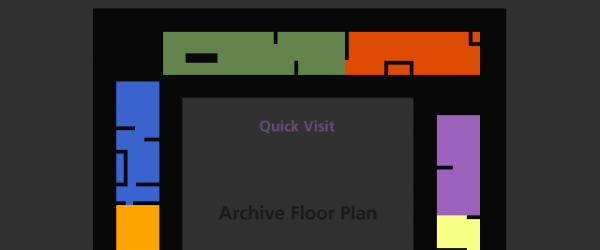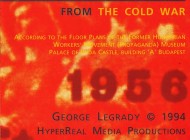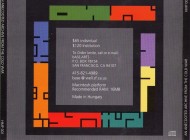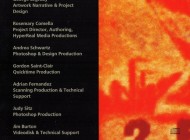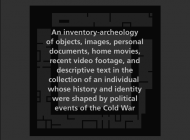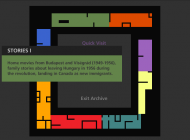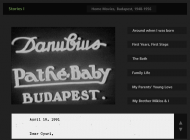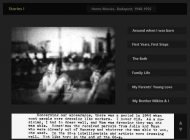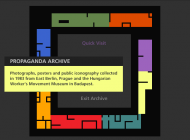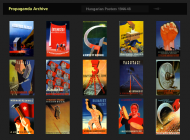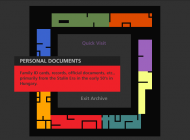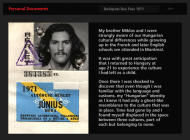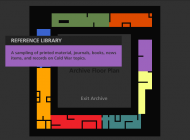An Anecdoted Archive from the Cold War
(When starting the cd-rom, to quit the intro sequence and go to the main menu, move the mouse out the cd-rom area and then in)
This project is both an interactive CD-ROM and a computer-media installation that explores the inscription of historical narrative through the process of archive construction.
George Legrady was born in Budapest in 1950 near the end of the Stalin era and grew up in Canada in the sixties' counter culture movement. The "Anecdoted Archive" reflects the author's particular hybridized history in relation to the Cold War. This non-linear index, or narrative features early 1950's East European, personal and official Communist material in the form of home movies, video footage of Eastern European places and events, objects, books, family documents, Socialist propaganda, money, sound recordings, news reports, identity cards, Western media reports, etc.
They are part of the author's collection of things and stories related to the Cold War that he has gathered during the past 20 years. These items, in the form of over sixty stories, have been arranged thematically in eight rooms superimposed on the original floor plan of the former "Workers' Movement" museum in Budapest, the official propaganda museum of the Communist Party.
[...] Interactive media and the digital environment are dependent on metaphor as the mode by which information, transformed back and forth from screen to memory, are given meaning. The "Anecdoted Archive" narrative also functions through a recognizable metaphor that makes access to the information meaningful: the museum as an architectural model and the museum floorplan as a conceptual space.
More on:
mat.ucsb.edu/g.legrady/glWeb/Projects/anecdote/Anecdote.html
About George Legrady
George Legrady was born in Budapest, immigrated to Montreal, Québec during the 1956 Hungarian uprising, moved to California in 1981 and currently has dual Canadian-American citizenship. He began his studies in classical music at Mont-Jesus-Marie in the French Canadian language. He transferred to Marymount High School, and from 1965 until 1969 was active as a rock and roll keyboard musician. He was introduced to fine arts photography by the artist Charles Gagnon and the photographer John Max during his undergraduate studies in Humanities at Loyola College. In 1976 he received his Masters of Fine Arts degree from the San Francisco Art Institute, then returned to Canada where he began his first fulltime teaching apointment at the University of Western Ontario. His artistic research work at that time was based on a theoretical and analytic examination of the conventions by which photographic images conveyed meaning. In 1981 he moved to La Jolla, California, and began computer programming as an artistic practice in the studio of Professor Harold Cohen at UCSD. From 1996 to 2000, he was professor at Merz Academie of Visual Communication in Stuttgart, Germany where he created the Interactive Media pathway with an emphasis on interface design, interactive installations, and motion sensing systems for multimedia installations. In fall 2000, her received his appointment at the University of California, Santa Barbara where he currently works and lives.
More on http://www.mat.ucsb.edu/g.legrady/glWeb/v/vitae.html
Technical Details
Authored with Director for Apple Mac.
Images Gallery
Medium / Platform
CD-ROM MacEnglish
Author
George Legrady
Producer
Hyperreal Media Productions (USA)
Uitgever
bASE.ARTS, San Francisco, 1994
Credits
George Legrady: Artwork narrative & Project design
Rosemary Comella: Project Director, Authoring, HyperReal Media Productions
Andrea Schwartz: Photoshop & Design production
Gordon Saint-Clair: QuickTime production
Adrian Fernandez: Scanning production & Technical support
Judy Sitz: Photoshop production
Jim Burton: Videodisk & Technical support
Resurrection Lab ➚
Een archief : 1999-2010-2019
Deze pagina is een archief van de iMAL website zoals die tussen 2010 en 2019 bestond. Alle activiteiten en projecten die sinds het begin in 1999 door iMAL georganiseerd zijn zijn hier gearchiveerd.
Het meest recente nieuws en activiteiten kan je terug vinden op onze nieuwe website: imal.org

